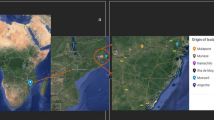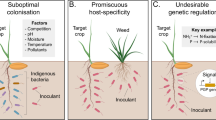Abstract
AN increase in beef cattle production on the 350 million hectares of acid, infertile savannahs of tropical South America would have a major impact on world food production. Production in these regions is limited by the inadequate nutritional value of the native vegetation, and legume-based pastures are now being introduced1 to raise the protein content of available forage. However, to obtain full benefit from biological nitrogen fixation through nodulated legumes it is necessary that the introduced legume form an effective symbiosis with Rhizobium. The low pH, limited availability of phosphorus, and very high levels of aluminium and manganese in these soils, are likely to affect nodulation and nitrogen fixation. It is therefore essential that strains of Rhizobium adapted to acid conditions are used. Alkali production by rhizobia from tropical legumes and the consequent rise in pH of test media has made the development of a simple test to select such strains difficult2. We report here that interference from alkali production can be eliminated by minor changes in the screening medium. This finding challenges the view that alkali production is a distinguishing characteristic with ecological significance3, and is also a starting point for detailed study of the effects of acidity and related factors on growth of Rhizobium.
This is a preview of subscription content, access via your institution
Access options
Subscribe to this journal
Receive 51 print issues and online access
$199.00 per year
only $3.90 per issue
Buy this article
- Purchase on Springer Link
- Instant access to full article PDF
Prices may be subject to local taxes which are calculated during checkout
Similar content being viewed by others
References
CIAT A. Rep. (1977).
Munns, D. N. in Exploiting the legume–Rhizobium symbiosis 211–236 (Uni. Hawaii, NIFTAL project, 1977).
Norris, D. O. Pl. Soil 22, 143–166 (1965).
Keyser, H. H. & Munns, D. N. Soil Sci. Soc. Am. Proc. (in the press).
Ishizawa, S. J. Sci. Soil Manure, Tokyo 24, 169–172 (1953).
Graham, P. H. & Parker, C. A. Pl. Soil 20, 383–396 (1964).
Graham, P. H. Antonie van Leeuwenhoek 30, 68–72 (1964).
Ishizawa, S. J. Sci. Soil Manure, Tokyo 24, 163–168 (1953).
Loneragan, J. F. in Use of Isotopes for Study of Fertilization of Legume Crops 1574 (IAEA Vienna, 1973).
Vincent, J. M. in A Manual for the Practical Study of the Root-nodule Bacteria (Blackwell, Oxford, 1970).
Author information
Authors and Affiliations
Rights and permissions
About this article
Cite this article
DATE, R., HALLIDAY, J. Selecting Rhizobium for acid, infertile soils of the tropics. Nature 277, 62–64 (1979). https://doi.org/10.1038/277062a0
Received:
Accepted:
Issue Date:
DOI: https://doi.org/10.1038/277062a0
This article is cited by
-
Use of Sugar Cane Vinasse to Mitigate Aluminum Toxicity to Saccharomyces cerevisiae
Archives of Environmental Contamination and Toxicology (2009)
-
Sugarcane molasses and yeast powder used in the Fructooligosaccharides production by Aspergillus japonicus-FCL 119T and Aspergillus niger ATCC 20611
Journal of Industrial Microbiology and Biotechnology (2006)
-
Manipulation of rhizobia microflora for improving legume productivity and soil fertility: A critical assessment
Plant and Soil (1995)
-
Selection for acid tolerance inRhizobium meliloti
Plant and Soil (1988)
Comments
By submitting a comment you agree to abide by our Terms and Community Guidelines. If you find something abusive or that does not comply with our terms or guidelines please flag it as inappropriate.



